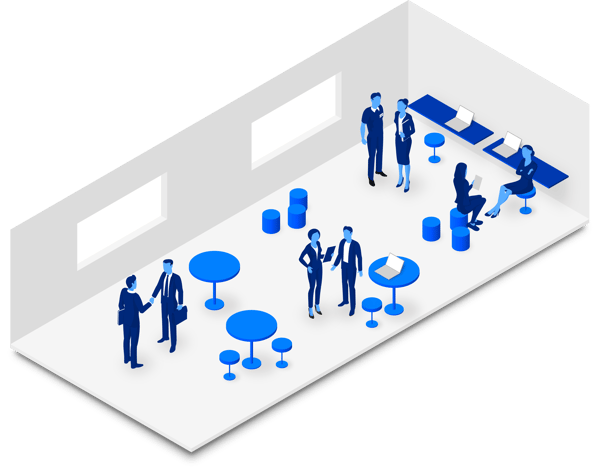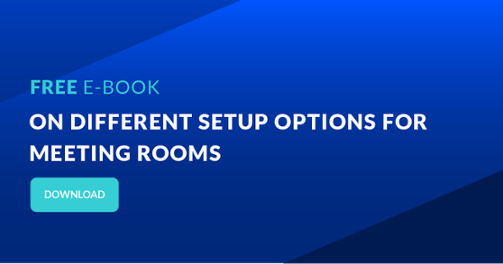Take a moment and imagine an ideal workplace. A workplace that engages employees, supports growth at all levels of the organization and creates an inclusive atmosphere for all employees. If you are looking to adapt your workplace to maximize its potential, there are a few things to consider. Here you will get six tips to create an ideal workplace environment.
Which elements are essential to create an ideal work environment?
If you had to decide and design the future workplace at your organization, how would you do so? Read the article and get inspired. At first try to take a moment and think about, which elements would be essential in your future office.
Do you have small rooms for focused and undisturbed work?


Or do you have large open spaces for collaboration and conversation?

Do you have the technology to help you unlock the full potential of your workplace?

Does your ideal work environment have?
- Flexible work hours to support your work-life balance?
- Clear expectations and predictable structures?
- Open office spaces to interact freely with your colleagues?
- Small rooms to focus on specific tasks?
- An assigned desk with all your professional and personal belongings?
- A lot of bookable desks to choose the location you want to work?
Choosing the optimal work environment that suits your needs comes with benefits, but also limitations. When you choose what your ideal workplace design should look like you create a static environment, thus, restricting its potential.
Here, you will get six tips to consider when designing your ideal work environment.
Create your ideal work environment

Tip #1: Chose a primary purpose for your office
In the traditional office you would have a clear purpose and function. The office was where you would come in to do your work. But with remote work and video conferencing software entering the workplace, the purpose of the office has become a bit blurrier. Today you can perform many of your tasks from home, during your commute, or in any other location of your choice. Therefore, some companies have decided to downscale the open office layout with assigned desks because many of their employees are working from home.
But if the office needs to have a greater purpose, what should the purpose of your office be? It is a good idea to think about creating zones that suit different needs such as:
- Communication and alignment – If your primary focus is to communicate and align in teams, you should dedicate some of your office space to meeting rooms for catch-up meetings.
- Being creative and innovative – If you work in a creative environment, you will want the environment to enable that creativity. Have a few collaboration zones, write-able walls, or whiteboards.
- Focus and concentration – Do you work in an environment that requires deep levels of focus? You should have small and quiet rooms to minimize distractions.
- Socializing between colleagues – If socialization between employees is a large priority you should think about making social zones, preferably close to the coffee machine.
Tip #2: Find a balance between flexibility and predictability
When creating the ideal work environment that suits your workplace and employees, it is important to consider a balance between flexibility and predictability. Work-from-home has opened the possibilities to make everyday tasks fit into the traditional 9-5 workstyle. But the increased flexibility comes at a cost.
A flexible work environment requires more planning and coordination to collaborate and execute tasks in teams. With increased flexibility comes less predictability. It is far more difficult to figure out who will be at the office on certain days.
How to create a balance between flexibility and predictability
- Schedule your workday in your Outlook Calendar to visualize your activities for your team.
- Plan specific days for focus work (if you are mainly in the office), or a specific day for a catch up in person (if you are mainly working remote).
- Use tools such as dashboards or displays to visualize availability.
Tip #3: Define your fixed and fluent workspaces
Should your ideal work environment consist of fixed workspaces or fluent workstations?
A fixed workplace is a static or non-changing work environment. This creates a lot of stability and reliability because your employees know how to use the workplace and can make work routines. There are less or no changes to the workspace layout, which makes it recognizable for employees, but it also limits the possibilities of maximizing your capacity.
A fluent workspace is a changeable environment, where you can change the office environment to fit your own needs. One example could be making some assigned desks into bookable desks, which is known as hot desks. This makes it possible for employees to collaborate across departments and find desks close to people, you would want to collaborate with. This is great for maximizing capacity.
Another example of a fluent workspace would be to make your resources changeable to fit your needs. Let us give you an example:
Let’s say you work at a company that has two meeting rooms and both rooms that have a capacity to fit four people. If you created the rooms as a fluent workspace, you might have sliding doors separating the rooms, which could enable you to combine the rooms to fit eight people if necessary.
Tip #4: Create rooms for open communication and private conversation
The workplace design could be used to create communication zones to enhance internal collaboration between teams or to limit the breach of private conversations. We see some enterprise-level organizations wanting to cut down on single office spaces for management because they want to optimize their office spaces while creating a flat hierarchical structure. This can be great to close the gap between management and employees, but it also means that management has fewer rooms for private and confidential conversations.
When creating an ideal work environment think about what your needs are in terms of having confidential talks or open communication. We see organizations opting for more and smaller rooms for phone calls and team calls. With a couple of soundproofed phonebooths, you will have a room for private conversations that makes it far easier to optimize your workplace capacity.

Tip #5: Create social zones to foster your work culture
In today's modern workplace, it is becoming increasingly important to create an environment that goes beyond the traditional office setup. While having a desk and computer is essential, companies are now recognizing the value of incorporating social zones into their office design. These social zones are dedicated spaces where employees can take breaks, relax, and engage in activities that foster a positive work culture.
Gone are the days of employees feeling chained to their desks for the entire workday. Instead, companies are embracing the idea that taking breaks and engaging in social interactions can actually improve productivity and overall job satisfaction. By creating social zones within the office, employees have a designated area where they can unwind, recharge, and connect with their colleagues.
These social zones can take many forms, depending on the company's culture and preferences. They can be as simple as a cozy lounge area with comfortable couches and chairs located near the coffee machine. This provides a space for employees to gather, chat, and enjoy a cup of coffee together.
The benefits of incorporating social zones into the workplace are numerous. Creating a space where employees can take breaks and engage in social interactions helps to reduce stress, increase job satisfaction, and boost overall morale. It also promotes a sense of belonging and community within the organization, as employees have opportunities to connect with one another on a more personal level.

Tip #6: Use technology to unlock the full potential of your workplace
In today's fast-paced business world, technology plays a crucial role in unlocking the full potential of the office. Gone are the days when meetings were restricted to physical conference rooms. With the integration of video conferencing software, organizations can now conduct online meetings seamlessly, connecting teams from different locations and time zones. This not only saves time and money on travel expenses but also enhances collaboration and efficiency.
Furthermore, organizations are increasingly implementing sensors like ubiqisense to track the utilization of workplace resources. These sensors provide valuable data on how spaces are being utilized, allowing organizations to optimize their office layout and make informed decisions about resource allocation. For example, if certain meeting rooms are consistently underutilized, organizations can repurpose them or even downsize to save costs. If there is high demand for specific areas, organizations can also consider expanding or re-configuring those spaces to better accommodate employees' needs.
One innovative solution that leverages technology to enhance workplace productivity is the AskCody Insights module. This module provides valuable insights into employee preferences and resource utilization, allowing organizations to make data-driven decisions. By analyzing the data collected, organizations can gain a deeper understanding of what resources their employees prefer and identify areas where they might be lacking.
For instance, if employees consistently book certain types of meeting rooms or workspaces, organizations can invest in more of those resources to meet the demand. Similarly, if certain resources are underutilized, organizations can explore ways to repurpose or eliminate them, optimizing space and reducing unnecessary costs.
Conclusion:
Plan your ideal work environment to boost your employees
Creating an ideal workplace environment requires careful consideration and planning. By defining the primary purpose of your office, finding a balance between flexibility and predictability, and creating fixed and fluent workspaces, you can maximize your workplace's potential.
Additionally, incorporating rooms for open communication and private conversation, social zones to foster work culture, and using technology to unlock the full potential of your workplace can further enhance the overall experience.
Take a moment to imagine your ideal workplace and start implementing these tips to create a workspace that engages employees, supports growth, and fosters inclusivity and a positive workplace culture. For more inspiration and ideas, check out the free E-Book provided below.




